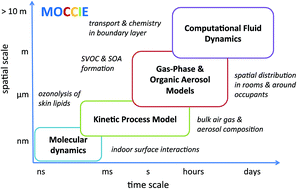Modelling consortium for chemistry of indoor environments (MOCCIE): integrating chemical processes from molecular to room scales
Abstract
We report on the development of a modelling consortium for chemistry in indoor environments that connects models over a range of spatial and temporal scales, from molecular to room scales and from sub-nanosecond to days, respectively. Our modeling approaches include molecular dynamics (MD) simulations, kinetic process modeling, gas-phase chemistry modeling, organic aerosol modeling, and computational fluid dynamics (CFD) simulations. These models are applied to investigate ozone reactions with skin and clothing, oxidation of volatile organic compounds and formation of secondary organic aerosols, and mass transport and partitioning of indoor species to surfaces. MD simulations provide molecular pictures of limonene adsorption on SiO2 and ozone interactions with the skin lipid squalene, providing kinetic parameters such as surface accommodation coefficient, desorption lifetime, and bulk diffusivity. These parameters then constrain kinetic process models, which resolve mass transport and chemical reactions in gas and condensed phases for analysis of experimental data. A detailed indoor chemical box model is applied to simulate α-pinene ozonolysis with improved representation of gas–particle partitioning. Application of 2D-volatility basis set reveals that OH-induced aging sometimes drives increases in indoor organic aerosol concentrations, due to organic mass functionalization and enhanced partitioning. CFD simulations show that concentrations of ozone and primary product change near the human surface rapidly, indicating non-uniform spatial distributions from the occupant surface to ambient air, while secondary ozone product is relatively well-mixed throughout the room. This development establishes a framework to integrate different modeling tools and experimental measurements, opening up an avenue for development of comprehensive and integrated models with representations of various chemistry in indoor environments.

- This article is part of the themed collections: Best Papers 2019 – Environmental Science: Processes & Impacts and Indoor Air: Sources, Chemistry and Health Effects


 Please wait while we load your content...
Please wait while we load your content...